Vegan Red Pozole (Pozole Rojo / Mexican Hominy Stew)
This favorite meatless red pozole is grounded with cascabel and chipotle chiles and spiked with citrus olive oil.
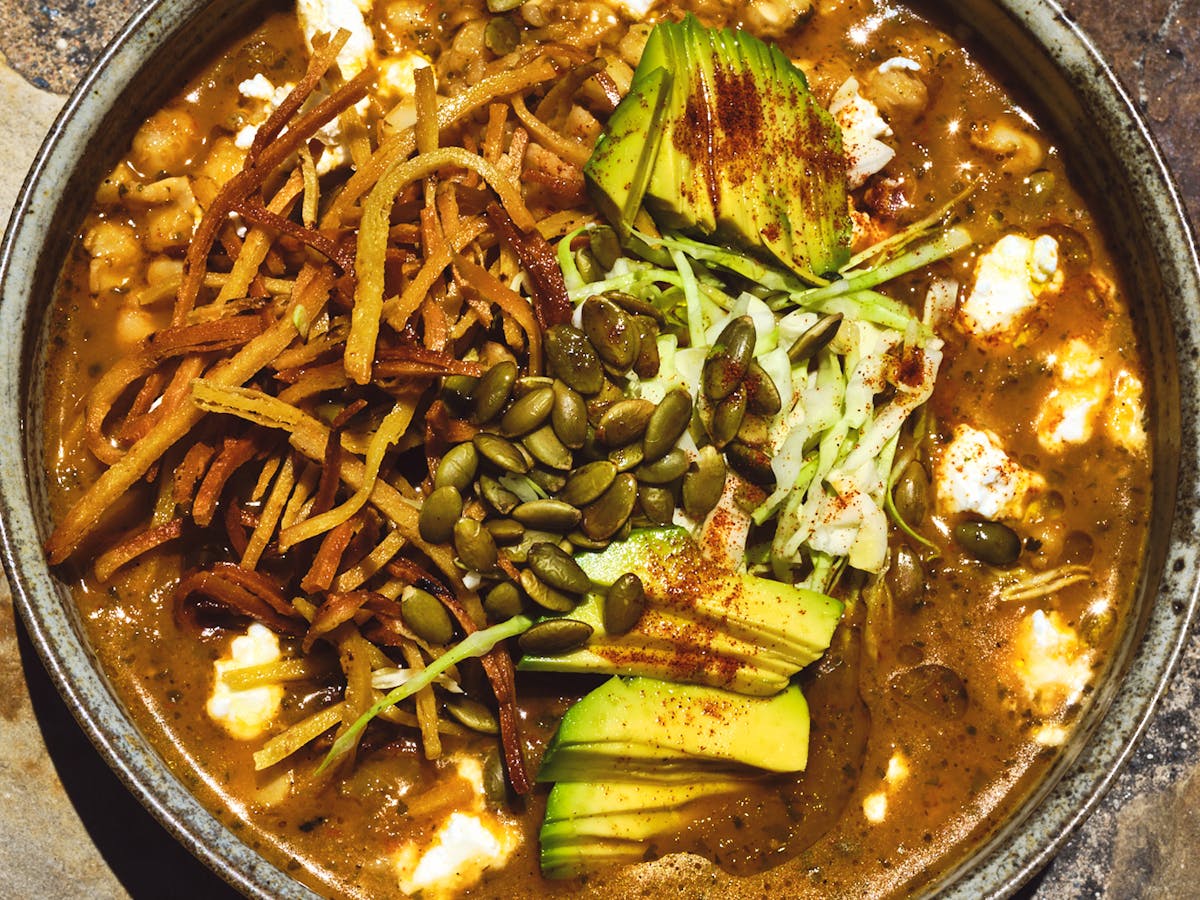
For many years our "house pozole" was a bright, vegetarian green pozole (pozole verde). It's a pozole made with serrano and poblano chiles, one that really goes for it on the cilantro and garlic fronts. It was my go-to pozole, I included the recipe in Near & Far and I would make it often in the summer when tomatillos are in season. Pozole, a Mexican hominy stew, is typically made with meat, but doesn’t have to be.
I’ve had a number of incredible vegetarian and vegan versions of pozole including the version I liked to order at Gracias Madre in San Francisco. There is a much loved vegan pozole served at Alta Baja Market in Santa Ana, but it has eluded me so far. You have to go on the last Sunday of every month (before they run out) and I hold out hope for my next visit.
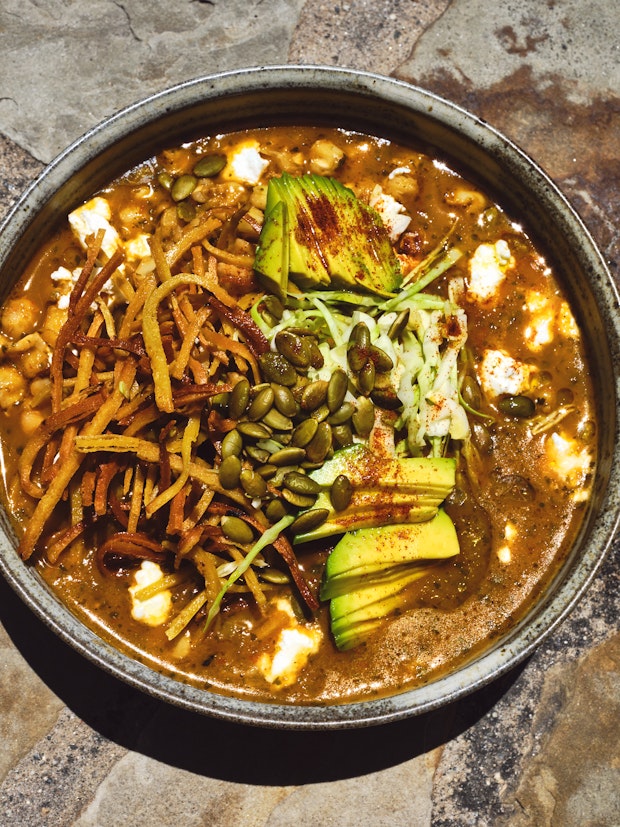
The recipe I’m going to to share today is actually a red pozole. It's a switch from the green pozole (pozole verde) we've made for so long, but it’s how I currently like to make pozole for myself, at home. A number of you have asked for the recipe, so here we go, with a bit of back story.
Wayne and I took a (very windy) road trip earlier this year, through the Southwest of the United States — from Los Angeles, California to Santa Fe, New Mexico. At the Santa Fe Farmers’ Market I bought a few pounds of beautiful, dried red posole. Along with that I scored some dried chipotle, cascabel chiles and fragrant Mexican oregano. In short, this haul prompted a shift from green to red when I returned home. 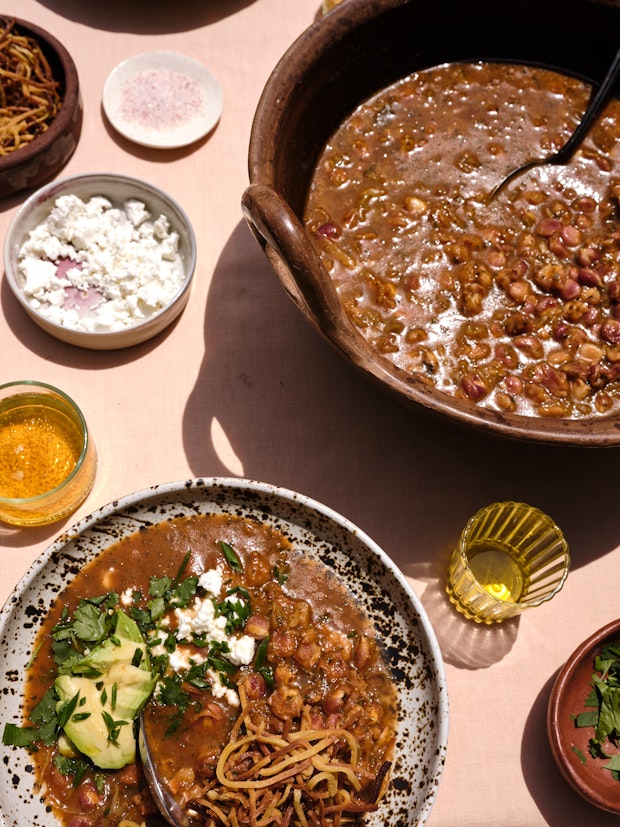
Pozole / Posole / Prepared Hominy
If you’re new to pozole-making you might be confused. Pozole (Posole) is the name of the stew, but *also* the primary, defining ingredient in that stew - nixtamalized maize or field corn. My understanding is the more traditional Mexican spelling is pozole, but you’re likely to see posole in the context of the Southwest. To add to the confusion you also see it called out as hominy. Ingredient lists (for pozole) often call for hominy, dried hominy, prepared hominy, and/or canned hominy. To succeed here, you need to make sure you're using nixtamalized corn / posole / hominy. I add links to favorite sources for dried (prepared & nixtamalized) posole down below as well as more links worth reading and exploring for a deeper dive.
Why is There Citrus in Your Pozole?
I suppose the most unusual aspect of this pozole recipe, aside from it being veg., is the high-volume introduction of numerous citrus accents. The first time I switched our “house” green pozole to an early version of this red one I felt like it needed some lift. It needed some sort of bright punctuation in flavor to counter the earthiness of the chile broth and starch of the pozole (hominy). I started reaching for nearby ingredients in my kitchen and garden.
It turns out adding a foundational citrus component or two was a game changer (beyond a squeeze of lime or lemon as a topping). Now I can’t imagine making veg. red pozole without it. A fatty drizzle of tangerine or lemon olive oil snaps everything into place. I also love to pick a few leaves off my makrut lime tree, sliver-slice whisper thin and add them to the pot in the final few minutes of simmering. I’ve used lemon zest as well on occasion. And *then* I love to serve bowls with wedges of lemon, lime or orange. Bonus points if they’ve been seared on a comal or grill, or in a pan.
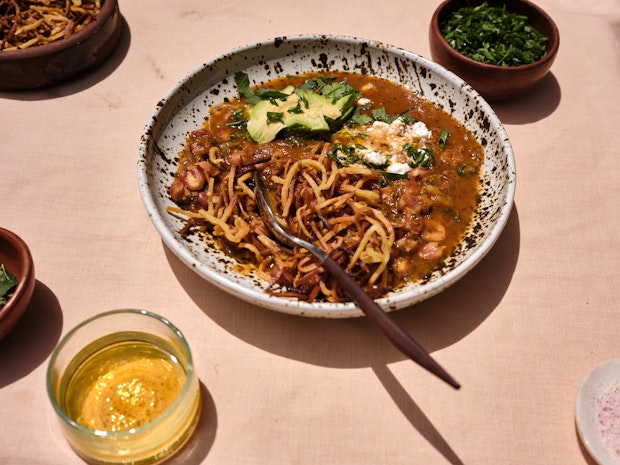
Canned vs. Dried Pozole (Hominy)
I never use canned hominy in my pozole (posole), I just don’t. By cooking dried pozole (hominy) you get beautiful blossoms of corn kernels plus a flavorful corn broth. You can carry that full-bodied broth over to your pot of pozole later in the process. My recommendation is to cook from dried and set up a great foundation from the start.
How To Make Pozole Video
Here's a quick little slideshow style video so you can see how it all comes together.
Where to Buy Dried Pozole (Posole)
After cooking through the red posole from Santa Fe I’ve been ordering a beautiful organic red posole via Southwest Heritage Mill. And my go-to white corn posole has long been from Rancho Gordo.
- Red Feathers Red Corn Posole
- Ready-To-Cook Hominy / White Corn Posole
Pozole Toppings //
One of the things to love about a big, celebratory pot of pozole is the way everyone is able to customize a bowl. The recipe I’m including below (pre-toppings) is naturally vegetarian, vegan, and gluten-free. This is part of what makes it such a great meal to prepare for a crowd. It accommodates a range of dietary preference with no added lift for the cook. Here’s a list of favorite toppings:
- Homemade Tortilla Strips: This is a topping worth going the extra mile. To make homemade tortilla strips (see photo), slice corn tortillas thinly with a sharp knife. Fry in 1/2-inch of oil *in batches* before transferring to paper towels. Sprinkle with a bit of salt. Repeat with remaining tortilla strips.
- A Bit of Something Creamy: I like a little something creamy to top things off and typically reach for whatever is on hand. To keep things vegan, grab a favorite crumbly vegan cheese (there are a number of nut based ones). Or, if dairy is in your wheelhouse - creme fraiche, sour cream, feta cubes, crumbled cotija or goat cheese all do the job.
- Citrus wedges: Limes, lemons, oranges - and as I mentioned up above, if you have a grill going, grilled citrus wedges are wonderful.
- Shredded Cabbage: There’s already a good amount of cabbage in my pozole base, but a little extra as a topping is always welcome.
- Avocado: A must. The creaminess of a ripe avocado contrasting with the tortilla strips is A-plus.
- Thinly Sliced Radishes
- Toasted Pepitas
- Fresh Cilantro
- More Citrus Olive Oil (for drizzling)

Make-Ahead Pozole
There is something special about the ritual of preparing pozole from start to finish in one go. It requires patience, planning, and some supervision over stretches of time. That said, there are many times when I need to break up the process and prepare components ahead of time. This allows a big pot of restorative pozole to come together in a relatively short period of time. I’ll do this if we’re driving from L.A. to see family in Northern California. The components start to thaw in the cooler on the drive up, and then just a few steps are needed to finish things up at the end of a long drive day. Everyone can help prep the toppings. The stages look something like this:
- Prep the Posole: Soak and cook the dried posole. Drain, saving the broth. Cool and freeze the kernels & broth separately until ready to use.
- Make the Chile-Tomato Concentrate: Create the chile, onion, tomato, cilantro component, pulse with a hand blender, and freeze until ready to use.
- Finish the Pozole: A few hours before you’re ready to cook, thaw the components and proceed with the recipe and toppings.
More Readings on Pozole
- Warming up to Vegan Pozole by Gustavo Arellano
- Learn the process of nixtamalizing corn for pozole (Masienda)
More Vegan Recipes
- Vegan "Fish" Tacos
- Vegan Sushi
- Vegan Nachos
- Vegan Ramen
- Simple Vegan Mayo
- Vegan Tamagoyaki
- even more vegan recipes!
Vegan Red Pozole (Pozole Rojo / Mexican Hominy Stew)
I like to use cascabel chiles here (and order big bags of them online), but if you need to substitute ancho chiles that will work too. This recipe calls for 5-6 cups of water or broth. You can swap in any liquid you have from cooking the dried posole here. I typically have about two cups. So I’ll use that plus 3-4 cups of water to get the desired consistency.
- 1 pound dried posole (pozole / hominy)
- 3 dried chipotle peppers, stemmed
- 2 dried cascabel chiles, stemmed and torn
- 1 white (or yellow) onion, quartered
- 3 large shallots or 1 red onion, quartered
- 7 medium cloves garlic, whole
- 2 medium tomatoes, cored
- 2 teaspoons fine grain sea salt, plus more to taste
- 1/4 cup extra-virgin olive oil
- 2 cups cilantro, chopped (tender stems ok)
- scant 1 tablespoon Mexican oregano
- 5-6 cups water or good-tasting broth
- 2-3 cups finely shredded green cabbage
- 2 makrut lime leaves, slivered (optional)
- 1 tablespoon tangerine or lemon olive oil
- Toppings: a favorite vegan cheese (or if you aren’t vegan and enjoy dairy - crumbled cotija, feta, goat cheese, crema or crème fraiche - are options), avocado, cilantro, thin slivers of freshly made tortilla chips, citrus wedges (lemon, lime, pixies), or see more topping ideas in the main post - nutrition calculated pre-toppings.
-
Cooking dried posole is similar to cooking dried beans. To cook the posole kernels, rinse and pick over the kernels, cover with water and let soak for at least six hours, or overnight. Drain, place in a large pot and cover with a few inches of water. Bring to a boil, and cook for about an hour, or until a good percentage of the kernels blossom. Drain, reserving the broth and set aside. If you're making this ahead of time, both the broth and the cooked posole kernels (drained) freeze well.
-
On hot, dry comal, cast iron pan, or under a broiler, toast the dried chiles for about a minute. Remove and soak the chiles in scalding water. Blister the onion, shallots, garlic, and tomato in the same way while the chiles soak. You’re after some blistering on all sides, it’ll take 15 mins or so. Peel the garlic when soft and transfer to a blender along with the blistered onion, shallots and tomato. Drain the chiles and add them to the blender along with the salt. Puree. I sometimes double this component and use half as a salsa.
-
Heat the olive oil in a large pot over medium-high heat. Carefully pour the pureed chile sauce into the pan - it should be hot enough to sizzle. Simmer for ten minutes and remove from heat. Stir in the cilantro, oregano and 1 cup of the water or broth. Pulse with a hand blender.
-
Add 4 more cups of water or broth and the cooked posole, bring back to a simmer over medium heat. Stir in the cabbage and makrut lime leaves, if using. Adjust with more water/broth and more salt if needed. Finish with the tangerine or lemon oil and serve with lots of toppings.
Serves 6-8.


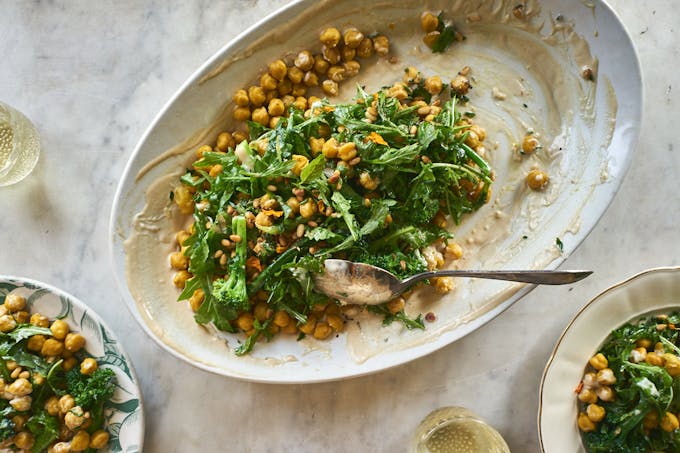

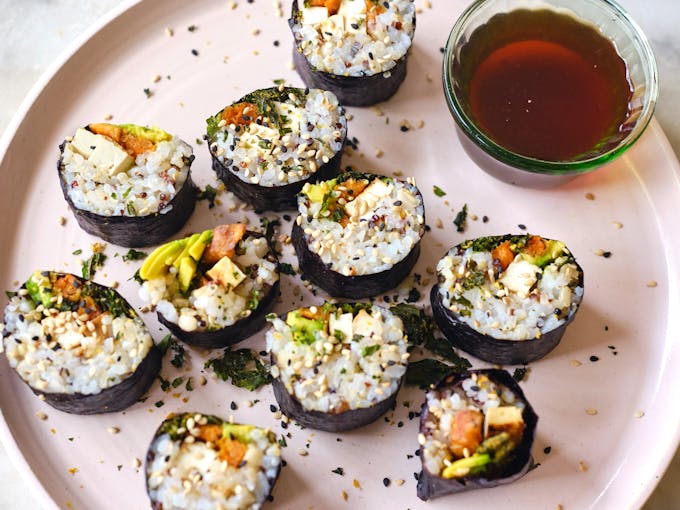

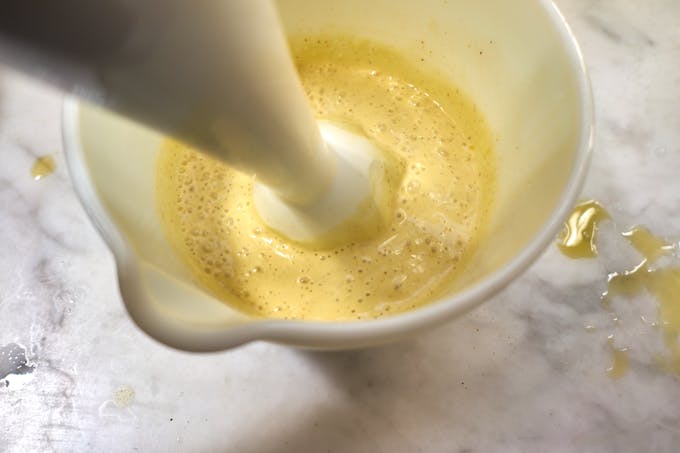
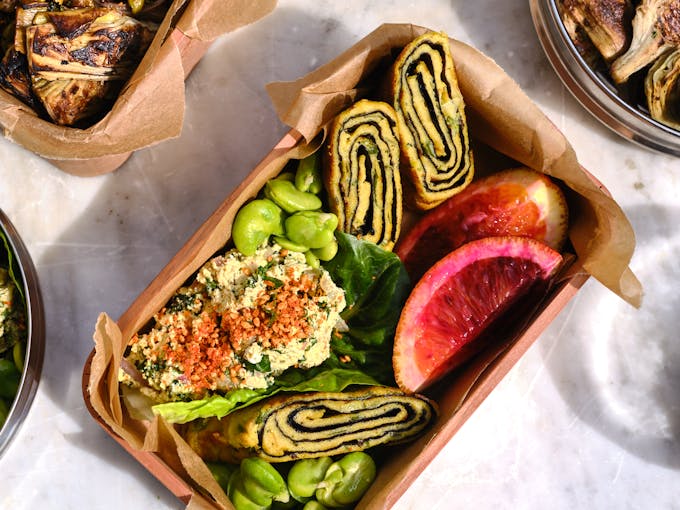
Post Your Comment
Comments
I have a bag of Rancho Gordo pozole but no chiles. I don’t have much chile selection near me. Can you recommend a place to order them?
Also, it’s the dead of winter here, so I am thinking maybe a drained can of fire roasted tomatoes added straight to the blender might work better than the sad “fresh” tomatoes I can get at the store right now. Please let me know if you see any reason this won’t work.
Hi hi! Poke around a bit online. You can order dried chiles from places like Boonville Barn Collective or Rancho Gordo. And yes, you can absolutely sub a few canned, fire-roasted tomatoes.
This has become a favorite posole for us and part of our regular dinner rotation! Your clear instructions really helped us jump into a new world of rehydrating dried peppers, and it has been such a fun journey. Thanks for the great recipe, as always!
Love this note, thanks Cyndi!
Hi! Rancho Gordo says to cook the hominy for 2 hours and your directions say to cook it for 1 hour. Is there a reason for this discrepancy? Just curious.
Hi Amy – cook them until they blossom. Some batches take longer than others.
This was so good. Dried hominy was not to be found, so I used one can and supplemented with an almost equal amount of pinto beans I had cooked from dried plus some of their cooking water. Used homemade veggie stock and only half the amount of cilantro. Seemed simpler to purée the 1c. broth with the herbs in the same blender I’d used for the chilis rather than use the hand blender. Didn’t think the cabbage added much, might try kale next time. Also didn’t have citrus oil but topped with a generous squirt of lime juice (among other things). Thank you for a crowd-pleasing, hearty recipe!
So happy you liked it Phoebe!
Is the Mexican oregano in this recipe fresh or dried?
Hi Lily, I tend to use dried.
I made this last night and loved it! I cooked the dried posole in my pressure cooker for 40 minutes and let it do a complete natural release. I also wanted to share a great local L.A. source for cascabel and other fun chiles is Northgate Market.
Thanks Lisa! There’s a Northgate near us as well – love browsing for chiles and picking up fresh masa. xx!
Made this yesterday with Guajillo (2) and Ancho chiles (3) and it was delicious! Thank you for the great recipe — we will repeat this one for sure.
So happy you enjoyed it Christine!
Hmmmm. Canned chipotles and canned hominy are more prevalent at my neighborhood Oakland grocery. I will try with those, and curious if you tried those. 🙂
Hi Lise – I haven’t. Give it a go & let us know how it turns out!
Hello, can I prepare the hominy in an Instant Pot? And if so, how long would you recommend cooking it? Thank you!
Yes! I think that would work beautifully, although I haven’t tested the timing.
More Recipes
Weekly recipes and inspirations.
Popular Ingredients